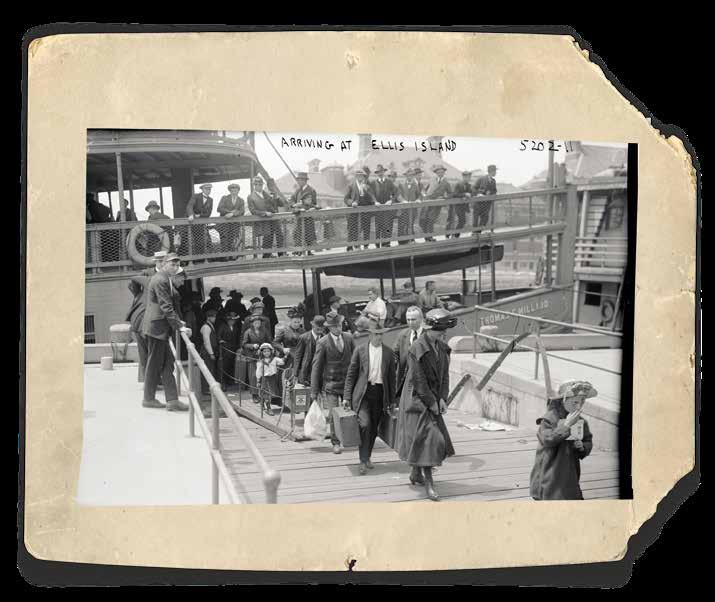
9 minute read
The Long Journey to Dakota Territory: Snapshots in Time
Immigrants arrive at Ellis Island for processing after journeying across the Atlantic Ocean. George Grantham Bain Collection, Library of Congress
The Long Journey to Dakota Territory: Snapshots In Time
Advertisement
By Jerry Tweton
They came by the thousands to North Dakota from Scandinavia, the Low Countries, the British Isles, Central Europe, European Russia, and even the Near East. The individual reasons for leaving their homelands to journey to America varied, but the desire for a better life in a new land unified those thousands of immigrants in a powerful way.
For the most part those who came from Northern and Central Europe left because there wasn’t enough land to support growing families. Only the first-born son would inherit land, leaving other sons out in the cold. Too, the waning of the industrial revolution caused economic hard times. The numbers who migrated to North Dakota from Northern and Central Europe were staggering. For examples, Norway, 46,000; Germany 16,500; Sweden, 12,000; Denmark, 5,300, Austria, 5,100.
Representative of those thousands are the Carroughs from Ireland, Ernest Kohlmeier from Germany, the Jerels from Switzerland, and the Fugelstads from Norway. Their stories provide a window through which to observe their journeys to America and North Dakota.
Eighteen-year-old Jennie Carrough migrated with her parents and four siblings from County Down, Ireland in 1880. An uncle who owned land in the United States’ Midwest lured the Carroughs to make the transatlantic journey with a promise of land. “The trip was fairly rough, and many of the passengers were ill,” she recalled. The food was frugal and poorly cooked. The ship, the Indiana, was decrepit; after the 14-day voyage the Indiana was condemned and taken out of service. Jennie, however, loved every minute of the trip which almost everyone else abhorred. A three-day train trip took the family to Iowa. She married Henry Laughlin soon after the arrival in Iowa; the couple completed their journey to a homestead near Carrington.
Ernest Kohlmeier was twenty-two years old when he was overcome by wanderlust. It was 1884. A friend of his tried to talk him into going to India. His employer, however, persuaded Ernest to go to the United States because, in his words, “In case of war you are safer there. They do not mix in with our wars.” His six-day journey on the steamship Fulda from Bremen to New York City was uneventful, as was the train ride to Dakota Territory. He landed near St. Thomas where his brother had successfully homesteaded. Eventually he preempted 160 acres in Rolette County.
In 1871, Andrew Jerel sold his farm near Braatz, Switzerland. With uncontrollable grief because of his wife Agnes’s death, he could not remain where everything reminded him of her. So, he decided to take his children to what he called “the land of plenty.” In Hamberg, Germany, the Jerels boarded the Homonia. Fifteen-year-old Agatha recalled the awful seasickness of the passengers on the boat. Three incidents especially remained in her memory. One of the passengers became ill and died. “They dropped her in the ocean,” Agatha remembered. ”I thought that was terrible at first, but later when I heard that the sharks would tip the boat over if they didn’t drop the body overboard, I felt different.” A near-collision with a larger steamer put the passengers in a terrible panic. “The next morning it was rumored that if the Homonia had been struck by the larger boat, we would have all perished.” Two days later the ship’s boiler failed, filling the passengers with fear. Repairs took three days, but the Homonia made it to New York City on May 2, 1871. The train took the family to Wisconsin where Agatha fell in love with and married Lorenz Arms. The couple eventually took up land near Wimbledon.
Terkel and Abigail Fuglestad, both in their late twenties, packed their clothes and set sail for America. The family’s small mountain farm would not support the couple, so they moved to Stavanger on Norway’s west coast where Terkel sought employment. He eventually found work in a shipyard, but hard times hit Stavanger in 1883, and Terkel lost his job. Just as the Fugelstads were set to begin their journey, he received word that he could have a job as Stavanger’s city gardener. But, alas, word came too late to cancel plans to sail to America. “It was God’s will, so it was for the best,” Terkel explained. “So good-bye Norway, and I left for the strange country of the Dakota prairies.”
The Fuglestads sailed from Rotterdam, Holland and arrived in New York fourteen days later. The couple was “near starved” after living on spoiled vegetables and half-raw biscuits for two weeks. Fortunately, they had brought a loaf of rye bread with them from Norway, but during the processing procedure, someone stole it.“ ”We jumped up and looked around, but the bread was stolen right out of our hands,” Terkel recalled. A short time later, Abigail’s ball of yarn disappeared. Terkel wondered if this was a warning of what they could expect in their new land.
Their steamship ticket called for them to continue their journey as freight goods on the Great Lakes from Buffalo, New York, to Duluth, Minnesota. They shared their “accommodations” with fourteen milk cows, a “flock of Finlanders,” one Swede, and of course, boxes of freight. After a week’s journey as Great Lakes’ cargo, they were unloaded, along with the cows, the Swede, and the Finlanders at a Duluth pier.
The journey continued by train, another week of torturous travel, which carried the Fugelstads to Valley City. Abigail’s brother met and guided them across the prairie to near Hannaford. Terkel: “At last we came to our destination where our future home was to be.” The journey had ended.
Just over 32,000 Germans who lived in the Black Sea region of Russia made the journey to North Dakota. In the 1760s, Catherine the Great, who desired to strengthen Russia’s agriculture, lured thousands of Germans to farm in that area to the north of the Black Sea. She provided free land, but just as important, she pledged that the Germans could remain German. They could live just as they had in Germany and were exempt from service in the Russian army. In the 1870s into the 1890s, Tsars Alexander II and Alexander III voided Catherine’s promises in order to “Russify” the Germans. The Germans were to become Russians. These actions, along with the lack of land for fourth and fifth generation Germans in Russia, prompted a mass exodus. Unlike those from Northern and Central Europe, who usually migrated as individuals or families, the Germans from Russia left in large family groups of up to fifty people. Representative of the journeys are the Maier, Mosbrucker, and Flegel families.
Christian Maier, Jr., was a fourth-generation German eking out a living on a very small farm near the Black Sea. Because of the scarcity of land for his generation, he decided to take his wife, Carolina, and daughter, Amelia, to America. It was April, 1886. His parents and younger brother opted to join the journey. The train trip to Bremen was uneventful but they had to wait there for eight days; they had missed their ship. Joined by seven other Black Sea families, the Maiers departed aboard the steamer Vera. Storms plagued the families with seasickness. “While I lay flat on my back in my room I wished I had remained in Russia,” Christian Jr. confessed. After the nine-day voyage and the three-day train ride, the Maiers arrived at Ellendale and finally settled not far from Ashley.
Philip and Eva Mosbrucker and Philip’s parents farmed small parcels of land just north of the Black Sea. Some of his father’s friends who had already migrated to North Dakota urged him to sell out and join them where land was “free,” building materials cheap, and free coal plentiful. Having difficulty making ends meet, he took their advice; the sale netted $400. The proceeds from the sale provided both families with enough money to purchase passage and start a new life in a new land. On December 27, 1888, joined by several other Black Sea families, they departed Rotterdam aboard the Mostom, a ship hardly fit for the sea. “I will never forget how close we came to sinking,” Christian Jr. recalled. Six days out, a terrible storm arose that lasted for three days and nights. Everybody on board knelt in prayer. The food was “not fit to eat” and accommodations were “not very clean.” The Mostom did make it to New York harbor and a pleasant train trip carried them to Mandan where friends greeted them. They homesteaded in Oliver County.
In 1889, August Flegel and his wife, Carolina, made the difficult decision to leave their Russian home near Kulm in the Black Sea region because they had a difficult time making a living on a five-acre farm. Carolina’s brother, Jacob Rieker, dreaded the five years he was required to serve in the Russian army and opted, along with other members of his family, for the journey to America. To raise money for the long sojourn, August sold his livestock, household furniture, farm equipment, and land for 700 rubles, about 350 American dollars. This would be more than adequate, he thought, to get to America and begin a new life for himself, his wife, who was in her ninth month of pregnancy, and three children, August Jr., age seven; Mathilda, age four; and one-year-old Nathaniel. They were joined in the journey by ten other German Russian families, numbering over fifty adults and children.

A Northern Pacific Railroad survey crew, including a Japanese immigrant, poses ca. 1885 near the Green River, Washington Territory.
University of Washington Libraries, UW2315
The large party planned to take the train to Bremen, Germany, the port from which most Germans from Russia sailed. Getting out of Russia proved to be difficult. Johannes Rieker was stopped at the border on grounds of desertion. The Rieker family remained with Johannes until they escaped across the border on a dark, moonless night.
Aboard the train to Bremen, the baby of the Krafts died suddenly. Not wanting to cause a further delay, the infant’s body was hidden in a basket. Upon arrival in Bremen, the body was turned over to a steamship agent who tended to necessary arrangements.
The Flegels and the other families waited a few days for their ship to come in. Meanwhile, it was discovered that Jacob Rieker had no money for passage. Reluctantly, August loaned him enough for his ticket. “I still had enough to pay my way to America, but very little else,” August recalled.
The crossing journey was not pleasant. Five days out of Bremen, their ship hit an iceberg. The damage was minimal, but, as August remembered, the incident “threw the passengers into a panic.” Most became seasick and as a result the third-class section of the ship “became pretty messy.”
Near the end of the ten-day crossing, the Flegel family faced one more obstacle. Their daughter, Mathilda, was not listed on the Flegel passport. The official threatened to send the four-year-old girl back to Bremen unless August paid for another full fare. He, of course, did, leaving the Flegels with very little money. The two-day train ride to Eureka, South Dakota, where hundreds of Germans from Russia stopped on their way to finding a homestead in North Dakota, went smoothly. Carolina gave birth to a healthy baby and the Flegels completed their journey by filing on land in Emmons County, North Dakota.
One historian has concluded that the immigrant “had a more treacherous and uncertain voyage than did the astronauts who went to the moon.” That may be an exaggeration, but leaving a known life in a known land for an unknown life in an unknown land did take tremendous courage. As the journey accounts reflect, the trek to, across, and from the Atlantic was not easy. The newcomers were driven by the dream of land that awaited them in the farmers’ last frontier, North Dakota.









